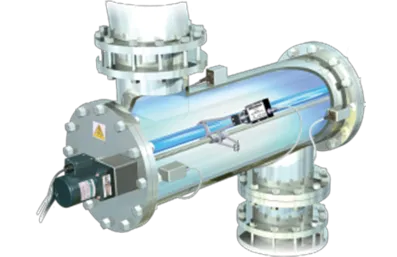
Ultraviolet System

Strong sunlight disinfects water by permanently de-activating bacteria, spores, moulds and viruses. Over a century ago, scientists identified the part of the electromagnetic spectrum responsible for this well-know effect; wavelengths betwen 200nm and 300nm, often called UV-C. The most effective single wavelength is typically UV at 265nm, however recent research in the USA has shown that 271nm light and 263nm light are the most effective UV wavelengths for the deactivation of particular target organisms.
The mechanism of kill is well documented and unlike chemical disinfectants the organism unable to develop any immune mechanisms. The mechanism of kill involves the absorption of photons of UV energy by the DNA, which fuses the DNA and prevents replication. DNA (Deoxyribonucleic acid) consists of a linear chain of nitrogen bases known as purines (adenine and guanine) and pyrimidines (thymine and cytosine). These compounds are linked along the chain by sugar-phosphate components. The DNA of most forms of life is double stranded and complimentary; the adenine in one strand is always opposite thymine in the other, and linked by a hydrogen bond, and guanine is always paired with cytosine by a hydrogen bond. The purine and pyrimidine combinations are called base pairs. When UV light of a germicidal wavelength is absorbed by the pyrimidine bases (usually thymine) the hydrogen bond is ruptured. The dimer that is formed links the two bases together, and this disruption in the DNA chain means that when the cell undergoes mitosis (cell division) the DNA is not able to replicate. The most effective wavelength to achieve this effect are found betwen 263nm to 275nm, and the peak wavelength distribution is dependent on the target organism.
Research is now being undertaken to verify the effect that shorter wavelength UV light has on the other cell membrane of the organism. This shorter wavelength is more energetic and is absorbed by the organism outer membrane. A lethal insult is effected, which means that the cell is unable to effectively regulate osmotic pressure. This effect coupled with the fusing of the DNA means that UV is a simple, elegant disinfectant and one that will increasingly replace the more traditional chemical techniques.
The mechanism of kill is well documented and unlike chemical disinfectants the organism unable to develop any immune mechanisms. The mechanism of kill involves the absorption of photons of UV energy by the DNA, which fuses the DNA and prevents replication. DNA (Deoxyribonucleic acid) consists of a linear chain of nitrogen bases known as purines (adenine and guanine) and pyrimidines (thymine and cytosine). These compounds are linked along the chain by sugar-phosphate components. The DNA of most forms of life is double stranded and complimentary; the adenine in one strand is always opposite thymine in the other, and linked by a hydrogen bond, and guanine is always paired with cytosine by a hydrogen bond. The purine and pyrimidine combinations are called base pairs. When UV light of a germicidal wavelength is absorbed by the pyrimidine bases (usually thymine) the hydrogen bond is ruptured. The dimer that is formed links the two bases together, and this disruption in the DNA chain means that when the cell undergoes mitosis (cell division) the DNA is not able to replicate. The most effective wavelength to achieve this effect are found betwen 263nm to 275nm, and the peak wavelength distribution is dependent on the target organism.
Research is now being undertaken to verify the effect that shorter wavelength UV light has on the other cell membrane of the organism. This shorter wavelength is more energetic and is absorbed by the organism outer membrane. A lethal insult is effected, which means that the cell is unable to effectively regulate osmotic pressure. This effect coupled with the fusing of the DNA means that UV is a simple, elegant disinfectant and one that will increasingly replace the more traditional chemical techniques.
